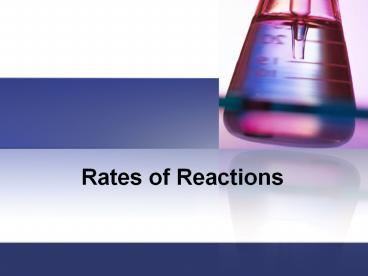Rates of Reactions - PowerPoint PPT Presentation
Title:
Rates of Reactions
Description:
Rates of Reactions Speed or rate is measured by the amount of change that occurs in a given time interval Rates REACTION RATE The amount of time it takes to use up ... – PowerPoint PPT presentation
Number of Views:400
Avg rating:3.0/5.0
Title: Rates of Reactions
1
Rates of Reactions
2
Rates
- Speed or rate is measured by the amount of change
that occurs in a given time interval
3
REACTION RATE
- The amount of time it takes to use up the
reactants (decrease in reactant concentration) - OR
- The amount of time it takes to make products
(increase in product concentration)
4
I.A. Reaction Rates
- Reaction Rate-change in concentration of
reactants and products in a given time period - Consider the following reaction
- 2 NO2 ? 2 NO O2
time (sec) NO2 0 4.0 M 5.0 3.1
M 10.0 2.5 M 15.0 2.1 M 20.0 1.8 M Sketch a
graph with t on the x-axis and M on the y-axis.
5
I.A. Reaction Rates
- 2 NO2 ? 2 NO O2
- How much NO is present at the beginning of the
reaction?
time (sec) NO2 0 4.0 M
5.0 3.1 M 10.0 2.5 M 15.0 2.1 M
20.0 1.8 M
NO
6
I.A. Reaction Rates
- 2 NO2 ? 2 NO O2
- How much NO2 was used up in the first 5 seconds?
- How much NO was produced?
time (sec) NO2 0 4.0 M
5.0 3.1 M 10.0 2.5 M 15.0 2.1 M
20.0 1.8 M
NO
0 M
- Calculate the moles of NO produced for each value
of t (always use the total moles of NO2 used up
to that point).
7
Collision Theory
- Reaction rate depends on the collisions between
reacting particles. - Effective collision? Reaction occurs
- Elastic collisions ? No reaction occurs
- Effective collisions occur if the particles...
- collide with each other
- have the correct orientation
- have enough kinetic energy to break bonds
8
- Particle Orientation
Required Orientation
Unsuccessful Collisions
Successful Collision
9
I.B. Collision Theory
Elastic Collisions
Effective Collisions
10
Activation Energy (Ea)
Even though the boulder will be more stable at
the bottom of the hill, it needs a push to get up
and over the bump first.
- depends on reactants
- low Ea fast rxn rate
11
Activation Energy (Ea)
- Minimum energy required for a reaction to occur
- Transition state-complex that is neither reactant
nor product
Activated Complex
Energy of products
?H - Difference between energy of reactants and
products
Energy of reactants
12
- Draw an energy diagram for an exothermic
reaction. Label the axes, reactants, products,
activated complex, activation energy, and change
in enthalpy.
13
Factors Affecting Reaction Rate
- 1. Nature of the Reactants
- 2. Concentration of Reactants
- 3. Surface Area of Reactants
- 4. Temperature
- 5. Catalysts
14
Factors Affecting Reaction Rate
- 1. Nature of the Reactants
- Certain bonds are easier to break than others
- Ca(s) 2H2O(l) ? H2(g) Ca(OH)2(aq)
- 2Na(s) 2H2O(l) ? H2(g) 2NaOH(aq)
- Na reacts with water faster than Ca because Na is
more reactive.
15
(No Transcript)
16
- 2. Concentration
high concentration the higher the
concentration ? the more molecules there are ?
the more collisions take place creating product
17
- 3. Surface Area
- the more surface a molecule can touch ? the
faster the reaction - Increase surface area by
- using smaller particles
- dissolving in water
18
Temperature
- 4. Temperature
- high temp fast reaction rate
- the hotter the molecules ? the more they move ?
the more they collide change into product
19
- Lower temp, more reactant particles have low amts
of kinetic energy - As temperature increases, more reactant particles
have higher kinetic energy - Only a small of particles will have enough
energy to form an activated complex.
20
Catalysts
- 5. Catalyst
- substance that increases reaction rate without
being consumed in the reaction - lowers the activation
- energy, more collisions
- will have enough energy
- to pass over the energy barrier
- reaction is faster because a greater fraction of
collisions is effective at any given point
21
- Catalysts in body
- Enzymes
- Breakdown sugars, proteins, etc
22
Reaction Mechanisms
- Many reactions occur in several steps.
- 2 O3 (g) ? 3 O2 (g)
- The decomposition of ozone to oxygen is catalyzed
by Cl.
23
Reaction Mechanisms
- Cl O3 ? ClO O2 Elementary step
- O3 ? O O2 Intermediates
- ClO O ? Cl O2 Add steps
- 2 O3 ? 3 O2
24
Reaction Mechanisms
- 2 NO ? N2O2 Fast
- N2O2 H2 ? N2O H2O Slow
- N2O H2 ? N2 H2O Fast
- Determine the original equation.
- Rate-determining step.
25
Reaction Mechanisms
- HBr NO2 ? HOBr NO Slow
- HBr HOBr ? H2O Br2 Fast
- What is the overall reaction?
- How many elementary steps?
- What are the intermediates?
- What is the rate-determining step?































